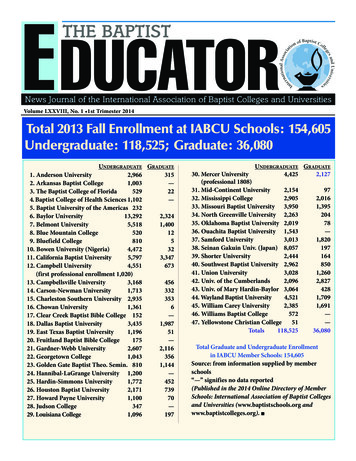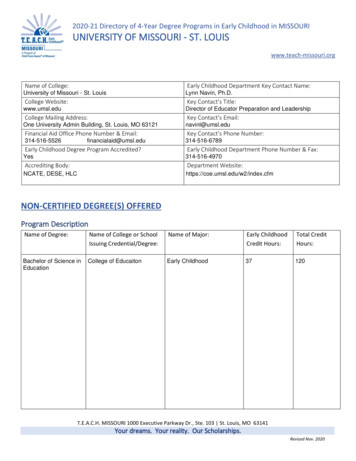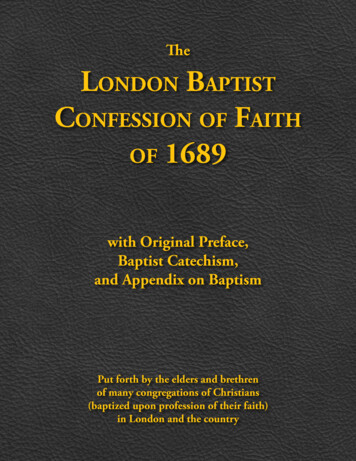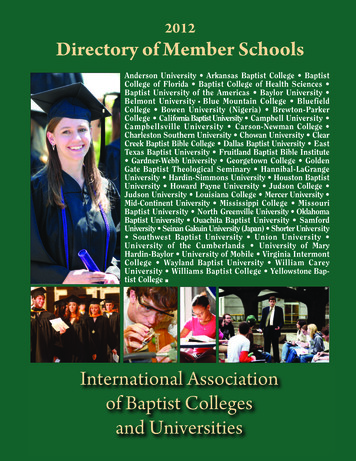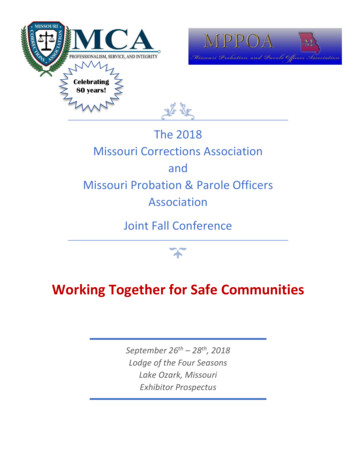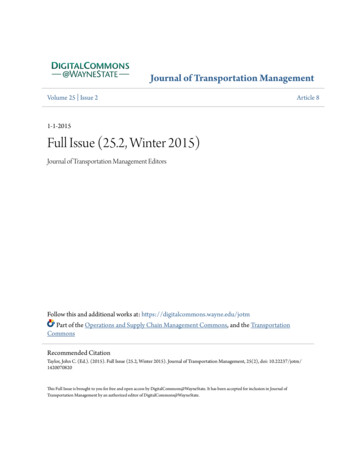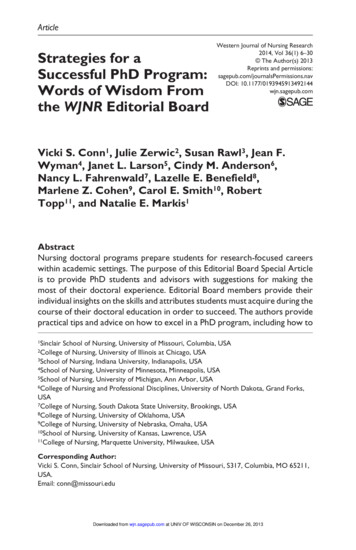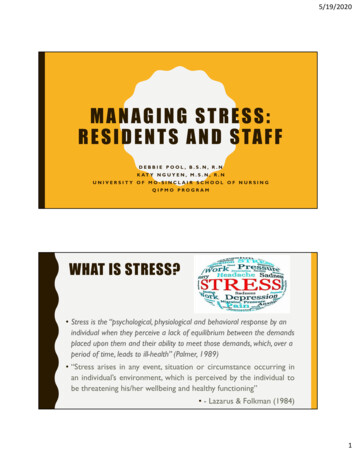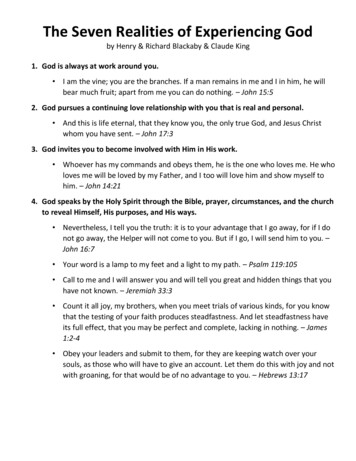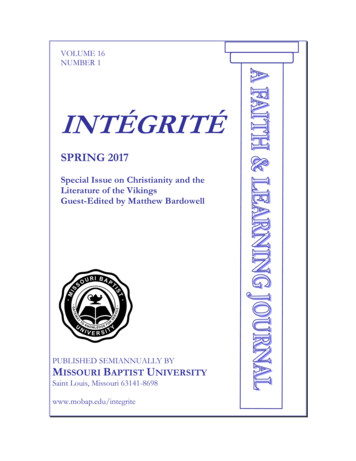
Transcription
VOLUME 16NUMBER 1INTÉGRITÉSPRING 2017Special Issue on Christianity and theLiterature of the VikingsGuest-Edited by Matthew BardowellPUBLISHED SEMIANNUALLY BYMISSOURI BAPTIST UNIVERSITYSaint Louis, Missouri 63141-8698www.mobap.edu/integrite
Intégrité:A Faith and Learning JournalEditorJohn J. Han, Missouri Baptist UniversityEditorial Review BoardMatthew Bardowell, Missouri Baptist UniversityTodd C. Ream, Taylor UniversityC. Clark Triplett, Missouri Baptist UniversityAdvisory BoardBob Agee, Oklahoma Baptist University & Union UniversityJane Beal, University of California, DavisAndy Chambers, Missouri Baptist UniversityJerry Deese, Missouri Baptist UniversityArlen Dykstra, Missouri Baptist UniversityHyun-Sook Kim, Yonsei UniversityDarren J. N. Middleton, Texas Christian UniversityJanice Neuleib, Illinois State UniversityEditorial AssistantsMary Ellen FuquayKrista KrekelerDouglas T. MorrisIntégrité: A Faith and Learning Journal (ISSN 1547-0474 and 1547-0873) is published in spring and fallby the Faith & Learning Committee and the Humanities Division of Missouri Baptist University, OneCollege Park Dr., St. Louis, Missouri 63141. Published both online http://www.mobap.edu/integrite/ and in print copy, the journal examines historical, philosophical, theological, cultural, and pedagogicalissues related to the integration of Christian faith and higher learning. All submissions are criticallyreviewed for content and substance by the editor and the editorial review board; in some cases, scholars inspecific fields are invited to evaluate manuscripts. The opinions expressed by individual writers in thisjournal are not necessarily endorsed by the editor, editorial board, or Missouri Baptist University. Intégrité(pronounced IN tay gri tay) is a French word translated into English as “totality,” “integrity,” “honesty,”“uprightness,” or “integration.” In his doctrine of the Christian life, John Calvin considered “intégrité” aswhole-hearted or integrated commitment to God. A Christian with such a commitment aims for singleminded devotion in Christ. Publication of the print edition of Intégrité has been made possible by fundingfrom Missouri Baptist University.SUBMISSIONS: Submissions of scholarly articles, short essays, review articles, book reviews, and poemsare welcome. Send your work as an e-mail attachment (Microsoft Word format) to the editor, John J. Han,at john.han@mobap.edu. We accept submissions all year round. For detailed submission guidelines, seethe last two pages of this journal.SUBSCRIPTIONS & BOOKS FOR REVIEW: Intégrité subscriptions, renewals, address changes, andbooks for review should be mailed to John J. Han, Editor of Intégrité, Missouri Baptist University, OneCollege Park Dr., St. Louis, Missouri 63141. Phone: (314) 392-2311/Fax: (314) 434-7596. Subscriptionrates: Individuals 10 per year; institutions 20 per year. An additional shipping fee ( 5-15 per year) ischarged for international subscription.INDEXING: Intégrité is listed in the Southern Baptist Periodical Index and the ChristianPeriodical Index.Volume 16, Number 1, Spring 2017 2017 Missouri Baptist University. All rights reserved.
Intégrité:A Faith and Learning JournalVolume 16Number 1Spring 2017Special Issue on Christianity and the Literature of the VikingsGuest-Edited by Matthew R. BardowellCONTENTS3A NOTE ON THE ISSUEINTRODUCTION4Matthew R. BardowellARTICLES13The Moon Glides, Death Rides: Pejoration and Aborted OtherworldlyJourneys in “The Dead Bridegroom Carries off his Bride” (ATU 365)Eric Shane Bryan31Christmas Eve of the Living Dead: The Satanic DraugrKent Pettit42The Problem of Emotion: Legal Codes and the Medieval IcelandicOutlawMatthew R. Bardowell52Christian Axioms and Cultural Moral Practice: Strengthening Faithin Studying Njáls sagaMichael David Elam64Viking Literature and Christianity: A Place-as-Text ApproachJonathan B. HimesBOOK REVIEWS73Nick Spencer. The Evolution of the West: How Christianity HasShaped Our Values.Dennis Pruitt79Torfi H. Tulinius. The Enigma of Egill: The Saga, The Viking Poet,and Snorri Sturluson.Matthew R. Bardowell
2Intégrité: A Faith and Learning Journal83David Jeffrey and Gregory Maillet. Christianity and Literature:Philosophical Foundations and Critical Practice.Matt Miller87NOTES ON CONTRIBUTORS89CALL FOR PAPERS AND BOOK REVIEWS
A Note on the IssueI am grateful to John J. Han, editor of Intégrité: A Faith and Learning Journal,for proposing this special issue on “Christianity and the Literature of theVikings.” Old Norse scholarship engages some of the most vibrant literature inthe medieval period, and I hope that Intégrité’s readership will enjoy the articlesincluded here and, perhaps, seek out some of these primary texts for their ownliterary edification. While studies in Old Norse literature can be wonderfullydiverting, they also tend to be highly specialized and technical. In view of this,we have taken a few steps to ensure that this issue is accessible.First, each article begins with an abstract to provide context as well as a concisestatement of that article’s argument. The reader will also notice that the names ofIcelandic authors are listed in the Works Cited page by first name. Thisconvention stems from the patronymic names that many Icelanders possess bywhich a person is idenitified not through a combination of forename and surnamebut by forename and patronymic, which usually consists of his or her father’sforename and the suffix –son (son) or –dóttir (daughter).Finally, a number of articles included in this issue cite primary sources in theoriginal Old Norse. I include below a pronunciation guide for some of the moreunusual characters. The pronunciation corresponds to the Modern Icelandicpronunciation of these characters as it appears in Michael Barnes’s A NewIntroduction to Old Norse, Part I, Grammar (London: Viking Society for NorthernResearch, 2008, p. 14-18).áíóǫ, ø, öÞ (þ)Ð (ð)æjas in English nowas in English eatas in American roamas in French peuras in English thinkas in English thisas in English myas in English year
Intégrité: A Faith and Learning JournalVol. 16, No. 1 (Spring 2017): 4-12IntroductionMatthew R. BardowellWhat does the literature of the Vikings have to do with faith and learning?This is a reasonable question for Intégrité readers to ask. The answer is alsoreasonable once one is initiated into some of the history and culture of medievalIceland, and so this introduction aims to provide a brief initiation. First, it isimportant to know about whom we speak when we talk about the Vikings. Whilein the popular imagination the label “Viking” has become synonymous withbearded men, horn-pronged helmets, and a fierce dispositions, the term itselfderives from the Old Norse word vík, which refers to the “small creeks” or“inlets” that dot the coasts in Scandinavian geography (An Icelandic-EnglishDictionary 716). Thus, Vikings were named for the practice of roaming from inletto inlet in ships with the intention of pillaging whatever could be found so as toaccrue honor and wealth before settling down to a more domestic lifestyle (716).Therefore, to think of “Viking” as a fixed identity is inaccurate. Put another way,“Viking” is not something you are, it is something you do. It was the medievalIcelandic version of a “gap year.” The literature of the Vikings, then, refers notonly to stories of conquest and violence but to the day-to-day conflicts andambitions of Iceland’s inhabitants after the “viking” was over.Among these narratives is a pivotal moment in Iceland’s history: itsconversion to Christianity at the turn of the millenium. The shift this momentbrought to the island is the focal point of the articles included in this issue. Thus,these primary sources are themselves concerned with faith and learning, as theydemonstrate how religions were practiced and propagated. Before theirconversion to Christianity, medieval Icelanders would have adhered toScandinavian paganism. The tenth-century English abbot, Ælfric of Eynsham,rails against the deities of this heathen faith in his homily “On the False Gods”(De Falsis Diis). In this text, Ælfric names various deities—Odin, Thor, andFrigg, among others—and argues that they are the counterparts of Roman godsand goddesses, all of whom are revered despite the shamefulness of the storiesattributed to them (681-6). The practices common to this faith are discussed insome detail in texts such as Tacitus’s Germania as well as the Ibn Fadlan’sJourney to Russia.1 While the precise motivation for Tacitus’s ethnographic workon the Germanic people is unclear, he presents them as a noble people who maypose a threat to Rome (Bernario 3). While these interests may have colored hispresentation, Tacitus offers glimpses into their pagan faith when he discusses theirchief gods and how the Germanic people worship them (Tacitus 23). BothTacitus and Ibn Fadlan relate the practice of offering human sacrifices and theconsecration of “groves and glades” to their gods (Tacitus 23; Frye 66-71). TheIbn Fadlan account relates one particularly disturbing tale of the ritual killing of a
Matthew R. Bardowell5slave girl on the occasion of a chieftain’s death, a scene that will be discussed inmore depth in Eric Shane Bryan’s essay below. This pagan faith was prominenteven as Iceland was first settled in the ninth century. Both Landnámabók (Bookof Settlements) and Eyrbyggja saga (The Saga of the People of Eyri) relate thatthe first settlers relied upon the gods to guide them to the place on the islandwhere they should build their farmsteads. As their boats approached the island,they would throw overboard the high-seat pillars, ornamental posts that decoratedthe sides of the seats of honor in a Scandinavian hall, often shaped to resemblegods such as Thor—and seek the place where they drifted ashore (An IcelandicEnglish Dictionary 765). That these pillars were among the things the earlyIcelandic settlers brought from home reveals the reverence with which they weretreated, and their willingness to settle wherever these pillars reached land showstheir dependence upon the gods for guidance and prosperity. It is worth notinghere that a good deal of our understanding concerning Scandinavian paganismpasses to us from texts produced after Iceland accepts Christianity. Thus, scholarsnote that characterizations of the pagan past may well be Christian constructs(Orri Vésteinsson 7). Consequently, it is important to bear in mind that accountsof Iceland’s pre-Christian past are complicated by their Christian present.A long campaign of persuasion, argument, and force eventually broughtabout a break with these old gods in favor of the new faith. Iceland’s relationshipwith Christianity extends farther back than the conversion in 1000. The Book ofIcelanders (Íslendingabók) notes that Christians had been on the island from thetime of the first settlers. Ari Þorgilsson explains that Irish missionaries spent timeon the island and ultimately left “because they did not wish to stay here withheathens” (4; ch. 1). These Irish Christians were not missionaries but monks, whowere likely itinerant Christians who had forsaken their homeland in devotion toChrist (17; n. 18). The stories that tell of Iceland’s later acceptance ofChristianity reveal much about the way the medieval Icelanders experiencedreligion, and the nuances of these accounts are still the subject of scholarly debatetoday. The most notable primary texts for the conversion are Theodoricusmonachus’s Historia de antiquitate regum Norwagiensium (The Ancient Historyof the Norwegian Kings), Historia Norweigiae Ágrip, Oddr Snorrason’s Óláfssaga Tryggvasonar (Olaf Tryggvason’s Saga), Snorri Sturluson’s Heimskringla,Brennu-Njáls saga (Njal’s Saga), Kristni saga (The Story of the Conversion), andÓláfs saga Tryggvasonar en mesta (Greatest Saga of Olaf Tryggvason) (Faulkes118; n. 32). Perhaps the most detailed of these accounts is the one given in TheStory of the Conversion, and the following brief synopsis of how Christianitycame to Iceland is adapted from this source.A man named Þorvaldr Koðránsson encounters a bishop named Friðrekr inthe south of Norway while on a raiding voyage and receives baptism from him.Þorvaldr petitions Friðrekr to go to Iceland to baptize his father, and the two menarrive there in the summer of 981. The men are reported to have traveled acrossthe Northern Quarter of Iceland preaching to the inhabitants there, a duty that fellto Þorvaldr because Friðrekr did not speak the language. When Þorvaldr presentshis father with the tenets of the new faith, he is reluctant to embrace it. He directsthe two missionaries to a large stone in which he believes his guardian spirit
6Intégrité: A Faith and Learning Journalresides, saying that he cannot accept the new faith until he knows whetherFriðrekr is more powerful than the spirit in the stone. Friðrekr sings over thestone, and as he does so the stone splits in two. This demonstration is signenough for Þorvaldr’s father, and his household is baptized at once.The men continue to act as missionaries with varying degrees of success.They enjoy one notable victory at an Autumn feast during which Friðrekr displaysthe power of the new faith. Two berserkers, men believed to become so crazed inbattle that they cannot be harmed, approach and behave erratically, howling likewild beasts, walking through the fire, and threatening violence against the otherparty-goers. The people turn to Friðrekr and ask him to dispatch these two men.He consecrates the fire through which the berserkers are so arrogantly walking,and the next time they attempt to step through it their frenzied invincibility falters.They sustain serious burns, and this result emboldens the people to attack theberserkers and kill them. As this story shows, adherence to Christianity does notnecessarily preclude violence and killing in medieval Iceland. Indeed, DavidClark shows that the early Icelandic church interpreted Biblical accounts ofrevenge as precedent for such violence, and these allowances were then codifiedin the Icelandic laws (119-30).Subsequent missionary ventures for Friðrekr and Þorvaldr are lesssuccessful, and Þorvaldr’s impulse toward revenge drives a wedge between thetwo men. When opponents to the new faith induce poets to compose libelousverses insinuating that Þorvaldr and Friðrekr have borne children together,Þorvaldr, enraged, murders them for the offense. Consequently, the heathen menon the island label them as outlaws, which means they must leave the country orexpose themselves to violence and death without any of the protections granted byIcelandic law. Eventually, the people assemble a mob to burn their home to theground with Þorvaldr and Friðrekr inside. According to The Story of theConversion, the mob is deterred by a flock of birds that cause their horses to rearup and injure their riders so severely that the men must turn back. Despite thisapparent divine intervention, the first missionary journey ends in failure, asÞorvaldr and Friðrekr leave the island and are divided by Þorvaldr’s violent desirefor vengeance, which causes him, even as they are abroad, to exact vengeance ona heathen Icelander whose path happens to cross his own.After Þorvaldr and Friðrekr’s ill-fated conversion attempt, the nextcharacter to enter the story is Þangbrandr, who according to The Story of theConversion, was a chaplain in Jutland. Because Þangbrandr has “the manners ofa knight,” his brother, Bishop Albert, gives him a shield bearing an image of thecross and a crucified Christ (The Story of the Conversion 39). Þangbrandrconverts King Óláfr Tryggvasson and finds favor with him. He will soon need toavail himself of the king’s favor. Þangbrandr has something of a checkeredhistory and must flee Denmark after killing a man who attempts to take abeautiful Irish girl that Þangbrandr has bought. Þangbrandr seeks safety withKing Óláfr, who welcomes him and ordains him as a priest. At this point in thenarrative, Þangbrandr encounters more difficulty. The saga tells us thatÞangbrandr was “a very extravagant man and open-handed, and his money soonran out” (39). To bolster his wealth, Þangbrandr takes to raiding. This decision
Matthew R. Bardowell7no doubt will seem strange to modern readers. How can a priest reconcile araiding voyage with his faith? Indeed, the shield bearing the image of thecrucified Christ underscores the combination of piety and martial force thatcharacterize his approach to his missionary efforts and his personal conduct.Just as Friðrekr rejects Þorvaldr’s violent behaviour, King Óláfr isdispleased when he hears of Þangbrandr’s raids. When the king learns of “theunruly things Þangbrandr was doing, he summoned him to him and laid chargesagainst him and said that he should not be in his service, when he is a robber”(40). To make reconciliation for his transgressions, Þangbrandr agrees to journeyto Iceland as a missionary. King Óláfr himself had just fled the island after tryingto convert the people there and meeting with fierce opposition. Naturally, theIcelanders do not take kindly to King Óláfr’s strategies, which include“destroy[ing] temples and places of worship to break up idols” (40). WhenÞangbrandr arrives in Iceland the next summer, he faces a cold reception. Slowly,however, Þangbrandr begins to develop a small contingent of people amenable toChistianity, mainly through showing the power and efficacy of the faith.During the first missionary effort in Iceland, those who resist the new faithtake strength from the apparant power of their gods to drive away the invadingChristians. When Þorvaldr and Friðrekr are successfully slandered by the poets,this emboldens the heathen resistence. Similarly, when they are put to flight bythe crowd of men and leave the island, the Icelanders understand this as a victoryfor the pagan gods over the Christian God. This sense of power is evident froman exchange Þangbrandr has with Steinunn, a poetess. Here, Steinunn matchesÞangbrandr in his missionary zeal, except, in her case, she attempts to persuadehim of the supremacy of Thor (Þórr):2“Have you heard,” she said, “that Thor challenged Christ to a dueland that Christ didn’t dare to fight with him?”“What I have heard,” said Thangbrand, “is that Thor would bemere dust and ashes if God didn’t want him to live.”“Do you know,” she said “who wrecked your ship?”“What can you say about it?” he said. (Njal’s Saga 177)2Steinunn then utters two skaldic verses suggesting that Thor was responsible forÞangbrandr’s nautical misfortune. While we are told that “Thangbrand was silentwhile she spoke, but then spoke at length and showed everything she said to bewrong,” Njal’s Saga presents none of this speech (177). The implication, at leastfor Steinunn, appears to be that Þangbrand’s shipwreck is evidence in itselfagainst the power of his deity.As Þangbrandr continues in his efforts, he seems most effective when heappeals to the great power allegiance to the Christian God confers. In oneencounter with Síðu-Hallr, a man who would later become a significant proponentof Christianity on the island, Þangbrandr discusses the Archangel Michael.Impressed, Síðu-Hallr replies, “The one whom these angels serve must bepowerful indeed” (The Story of the Conversion 41). The account of thisconversation in Njal’s Saga includes an additional detail. Síðu-Hallr agrees to
8Intégrité: A Faith and Learning Journalconvert if Þangbrandr promises that Michael will be his guardian angel (Njal’sSaga 174). Might impressed the medieval Icelanders, and access to power istreated as reasonable grounds for religious conversion. Alongside this somewhatcynical view of early Icelandic piety, it is also possible to understand Síðu-Hallr’srequest in a more charitable light. Andrew Hamer, for instance, argues that thisrequest “reveals the earnestness of [Síðu-Hallr’s] desire to become a Christian,and the grace of God in allowing him the vision necessary to contemplate such afriendship” (107). With the Christian contingent slowly growing as moreinfluential Icelanders are won over to the new faith, something of a national crisisemerges. The heathens and the Christians begin to view their respective laws asincompatible, and the future of the commonwealth is threatened by this conflict.The Story of the Conversion reaches its climax at the Icelandic parliamentin the summer of 1000. After Þangbrandr leaves Iceland, two men take up thecause of conversion: Gizurr the White (hvíti) and his son-in-law HjaltiSkeggjason. With the help of King Óláfr, the men mount yet another effort tobring Christianity to the island. The heathens try to prevent Gizurr and Hjaltifrom attending the assembly but fail to do so. Once Gizurr and Hjalti begin tospeak, the saga reports that the “people were amazed by how eloquent they wereand how well they spoke, and such great fear came with their words that none oftheir enemies dared speak against them” (48). Rather than accept leadership ofthe Christian contingent and cement the division between opposing sides, SíðuHallr reaches an agreement with the heathen law-speaker, Þorgeirr, to recite boththe heathen and the Christian laws.3 What follows is one of the most enigmaticmoments of the conversion narrative. Þorgeirr lies down, spreads a cloak overhimself, “and lay like that all day and all night, until the same time the next day”(49). The cloak has been interpreted as a kind of chrysalis within which Þorgeirrprepares for spiritual metamorphosis as well as a ritual during which he tries todivine the future and seek supernatural guidance (Jón Hnefill Aðalsteinsson 142).When Þorgeirr emerges, he assembles the people and declares that all of Icelandwill accept the Christian faith. Þorgeirr reveals in his speech that a desire tomaintain unity and preserve the rule of law motivates his decision. “Thatsummer,” the saga informs us, “Christianity was made law in Iceland, onethousand years had passed from the Incarnation of our Lord Jesus Christ” (50).The effect of this religious shift was extreme, and scholars continue todebate the extent and nature of Iceland’s resulting transformation. Among themany consequences of the conversation was that Old Norse developed into awritten language (Meulengracht Sørenson 8). The Icelandic family sagas arethemselves written, vernacular accounts of events and people that range fromIceland’s pagan past to its Christian present. In some places, these authors betrayhints of their personal feelings regarding the behavior of saga characters who,while revered, sometimes pose problems for Christian codes of conduct. In TheSaga of the Sworn Brothers (Fóstbrœðra saga), the author makes the followingobservation after relating that Þorgeirr and Þormóðr swear pledges to avenge oneanother should either of them be killed: “For though people called themselvesChristians, their Christianity was still young and weak, so that many traces ofheathendom remained and entered into their customs. Thus it had been the
Matthew R. Bardowell9practice of illustrious men who made covenant between them that he whosurvived should avenge the other” (The Saga of the Sworn Brothers 85-86).Many of the texts discussed in this issue will have a similar degree of selfconsciousness about the behavior of the characters they describe. This selfconsciousness shows a discomfort with the cultural practices of Iceland even afterChristianity had infused the culture.The laws of the commonwealth were also committed to writing and theChristian laws were codified alongside Iceland’s societal laws. Þorgeirr’spronouncement that “all people in Iceland should be baptized and believe in oneGod” can seem on its face a nominal acceptance of the new faith, especially whenone considers that the old, heathen practices were allowed to continue if they werekept out of the public eye (The Story of the Conversion 50). But the lawsthemselves may offer clues that show the acceptance of the new faith ran deeperthan formal, public declarations. Among these are laws that obligate Icelandiccitizens to give what aid they can to families who must travel to have theirnewborn children baptized (Laws of Early Iceland 23). Those who refused toprovide shelter or draught animals for travel are subject to legal action. A priestwho refused to baptize a child may be outlawed (23). If a family cannot reach apriest for baptism, a layperson is required to perform the rite. Those presidingover baptism were required to recite certain words, which suggests that thelanguage of baptism may have been familiar enough to the layperson so as toreasonably expect faithful observance of the act (24-25). These expectationssuggest that learning was a central aspect of the new faith, even as parts of the oldfaith are retained through similar transmissions of knowledge.The articles included here examine texts that engage with many of theissues raised by Iceland’s religious history and its attempts to transmit religiousknowledge. They divide into two sections: critical studies and pedagogicalessays. The first of the critical studies, Eric Shane Bryan’s “The Moon Glides,Death Rides: Pejoration and Aborted Otherworldly Journeys in ‘The DeadBridegroom Carries off his Bride’ (ATU 365),” examines a nineteenth-centuryIcelandic folktale in which a young Deacon engaged to be married suffers anuntimely death. Strangely, the Deacon rises again, not to take his place amongthe angelic hosts, but to find his fiancé and to drag her with him into the grave.Working with Eddic poetry and ethnographic evidence, Bryan follows thedevelopment of this folktale from its pagan origins to its later, post-conversionform. As a result, Bryan argues that Christian influence lent this formerlylaudatory class of tales a sinister character. Bryan’s analysis shows the peculiarcast Icelandic folk belief sometimes gives to orthodox theology.Similarly, Kent Pettit’s article, “Christmas Eve of the Living Dead: TheSatanic Draugr,” examines the strained relationship between pre- and postChristian Iceland as it is told in the Old Norse family sagas Grettir’s Saga (Grettissaga) and The Saga of the People of Eyri. In his study, Pettit considers thesupernatural accounts of the Old Norse draugr, a reanimated corpse that returns towreak havoc on the living. Pettit focuses on the harm these draugar aim to bringto the newly converted Icelandic Christians. He interprets these apparitions as asign of the old faith striving against the new, even after the matter of formal
10Intégrité: A Faith and Learning Journalconversion had been settled legally at the Althing. Pettit pays particular attentionto the manner in which these walking undead can be vanquished as well as thecharacters who succeed in destroying them. Pettit argues that these draugarrepresent perversions of Christ’s bodily resurrection, and, using English texts thatpresent similar hauntings, he suggests that these tales convey Christ’s power tosave people not only from their sins, but also from the enduring horrors ofpaganism.My article, “The Problem of Emotion: Legal Codes and the MedievalIcelandic Outlaw” shifts the discussion from spiritual outcasts to social outcasts.The laws of early Iceland are woven through many facets of daily life, even instories of the walking undead, and here I consider the limitations of the law toaddress the emotional needs of the offended. Focusing on Njal’s Saga, I examinethe specific case of the medieval Icelandic outlaw and the characteristics thatmake individuals more likely to be burdened with this label. I argue that sagacharacters who are induced to act on their emotions often transgress the lawbecause of the pragmatism encoded within Icelandic social expectations. In viewof these realities, I argue that Christianity brings with it new possibilities forreconciling one’s emotional needs with the pragmatism medieval Icelandicsociety prizes.The following two pedagogical essays consider ways to incorporate theliterature of the Vikings into English courses at the college and university level.Michael David Elam’s essay, “Christian Axioms and Cultural Moral Practice:Strengthening Faith in Studying Njáls saga,” proposes strategies for teaching OldNorse literature at Christian schools. Elam recognizes the difficulty these textssometimes present for modern readers who approach them with strong moralconvictions. Elam encourages us to use these challenges to broaden students’literary sensibilities so that they learn to attend charitably to different cultural andsocial conventions. Elam argues that to engage thoughtfully with such cultures isnot to embrace their practices, and, indeed, students may find that such contactstrengthens their faith as well as their ability to render thoughtful culturalcritiques.Jonathan B. Himes’s pedagogical essay “Viking Literature andChristianity: A Place-as-Text Approach,” suggests that charitable and productiveengagements with Old Norse literature extend beyond one’s judgments. Anopenness to texts, Himes suggests, can also be cultivated by treating literarysettings as texts themselves. Himes relates his experience teaching “Myths &Epics of Northwestern Europe” as a travel study course and describes howlearning in the environments in which these texts were composed or are believedto have taken place makes literature more accessible for students. Students whostudy the literature of the Viking must overcome a high degree of alterity to feelcomfortable with these texts. Himes argues that a place-as-text approach aidsstudents in this task. He also demonstrates how professors may adapt the placeas-text method to texts that may be native to their own geographical locations.As one might expect, such deeply ingrained religious beliefs and practicesdo not vanish overnight. After Iceland accepted Christianity, the paganism ofmany of the island’s inhabitants persisted in various forms. The essays included
Matthew R. Bardowell 11here, much like the text
important to know about whom we speak when we talk about the Vikings. While in the popular imagination the label “Viking” has become synonymous with bearded men, horn-pronged helmets, and a fierce dispositions, the term itself derives from the Old Norse

